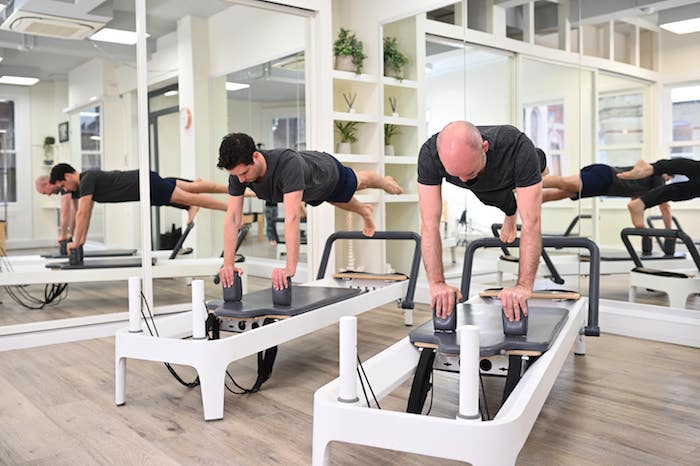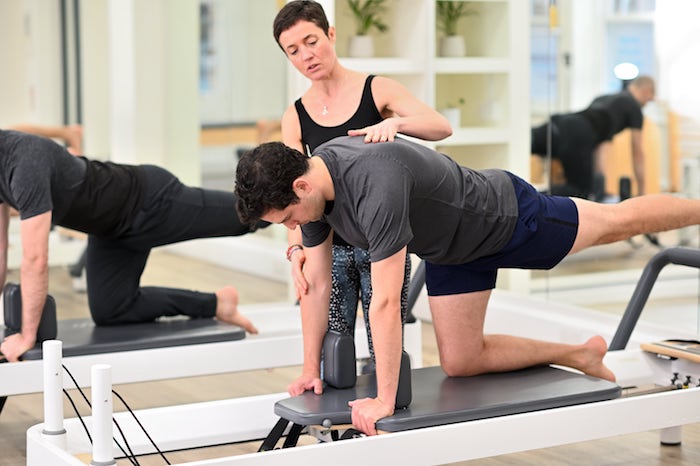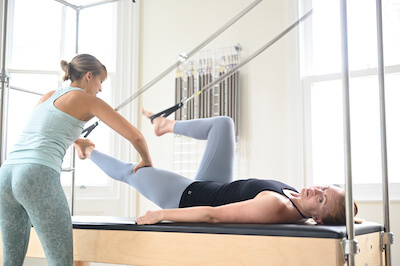Pilates can form an important part of your recovery and rehabilitation after prostate cancer surgery or treatment.
There are be specific guidelines to follow for returning to exercise after your surgery which we will discuss in this article.
Pelvic floor exercises will be part of the guidelines and should be done by every man undergoing treatment for prostate cancer. We will explain why this is important and how to include them in your daily life and exercise programme.
There are numerous studies that show the benefits of physical activity and exercise after cancer and cancer treatment. Some of these have looked at prostate cancer specifically and found that physical activity reduces the risk of prostate cancer mortality by 30%. It also showed that physical activity slowed disease progression by up to 57%.
These statistics mean that exercise needs to be considered as an important part of the treatment and management of cancer, it is something that everyone can access, and take part in, if they are given the correct advice.

Physical activity can help to regulate the way cancer cells grow, and repair DNA. More research is being done in this area to have a full understanding of how exercise helps to fight cancer. We do know that it is not just a case of being mobile and active making you feel better, it has an effect at a cellular level, not only to fight cancer, but prevent its recurrence.
Exercise before prostate surgery
One of the issues that is commonly seen is that men tend to reduce activity levels when diagnosed with prostate cancer. Ideally you should maintain your physical activity and aim to reach the NHS guidelines of 150 minutes per week of moderate activity.
It doesn’t matter what sort of exercise you do; it needs to be something that you enjoy and perhaps something that you can do with others to keep you motivated.
If you are undergoing treatment for cancer you may need to modify what you do depending on how you are feeling and if you suffer from fatigue. Exercise can help with those symptoms and side effects so doing little and often rather than one bigger workout is a good option.
Don’t forget that all physical activity counts! This could include walking the dog and gardening. Having a goal such as achieving 10,000 steps per day can be a good idea, or if you are less active normally just getting off the bus one stop earlier and walking is an easier change to make. Every little helps and small changes over time add up.

If you are due to have prostate surgery, start doing your pelvic floor exercises now! The pelvic floor is a sling of muscles underneath your pelvis that supports your bladder and bowel. It is common for men to have problems with bladder and bowel control and sexual function after prostate surgery. Pelvic floor exercises can help to reduce these symptoms and doing them pre-op can help to speed your recovery afterwards.
You can find lots of information on how to exercise your pelvic floor on our pelvic floor exercises for men page.
Exercise after prostate surgery
After having surgery, you will need to allow your body to rest and recover for a few weeks. You may have a catheter for between one and three weeks.
Until the catheter is removed you should do the following:
- Get up and out of bed day 1 after the surgery – this reduces the risk of deep vein thromboses which are blood clots that can be dangerous.
- Start walking as soon as you feel comfortable
- Do breathing exercises to reduce the risk of respiratory infection and to start to train the diaphragm that works with your core and pelvic floor
- Avoid any heavy lifting or direct pressure such as cycling.
Once the catheter is removed you should:
- Start doing your regular pelvic floor exercises every day
- Gradually increase your light exercise over the first four weeks – this can include Pilates for men
- Begin returning to gym and normal sports at around 6 weeks
- Gradually return to heavier lifting including weights in the gym from around 6 weeks
- Avoid cycling for 12 weeks due to pressure from the saddle directly on the area of the prostate
- Continue with effective pelvic floor and core control exercises if you are feeling any bladder weakness symptoms, and ideally as an ongoing part of your exercise regime.
- See a pelvic health physio if you have any ongoing concerns regarding activity levels, pelvic pain, bladder or bowel control or sexual function
- Remember that taking part in regular physical activity is one of the most effective ways to slow disease progression and reduce mortality

How can Pilates for prostate surgery help?
Pilates is a perfect form of exercise if you are undergoing prostate surgery. It is low impact and focuses on the activation of your primary stabilising muscles of the pelvic floor, deep abdominals, deep spinal muscles, and diaphragm. These muscles together make up the ‘core’.
Pelvic floor exercises are advised to all patients undergoing prostate surgery or prostate cancer treatment to reduce side effects. In Pilates you can learn to use the pelvic floor with the other stabilising muscles with your specific functional goals in mind. We progress your sessions so that you are working towards being strong and confident in your normal everyday life, not just for immediate recovery from surgery.
The Pilates equipment can be used to assist and resist movement. You can get back to Pilates as soon as you feel comfortable to move and it can be modified to be appropriate at all stages of your recovery.
Pilates should also be an ongoing part of your regular exercise routine. It is important to be physically active for life after prostate treatment as it slows the disease progression by up to 57% and reduces the risk of cancer mortality by 30% . You should aim for the NHS guidelines of 150 mins of moderate exercise each week including 1-2 strength training sessions. Pilates can form part of the general exercise and strength component.

Resistance training and weight bearing exercise is also important if you are having hormone therapy and at risk of reduced bone density. Weight bearing, resisted, and impact exercise stimulates the bone to lay down bone so can help to maintain bone density and reduce the risk of fracture.
How much physical exercise should you do?
This depends on the stage of treatment or how long it is since your surgery. You should follow the general guidelines above after surgery and the advice of your surgeon and clinical support team. It will also depend on your fitness levels. Even a little movement can help so some days that might be a short walk or going up and down the stairs more often at home.
As already discussed you should be aiming for the 150 minutes per week or 30 minutes per day of moderate physical activity but take it at your pace and build up gradually if you need to. Moderate should be similar to the level of a brisk walk, where you can feel your heart and lungs working but you are still able to speak in sentences.
Everyone’s goals will be different, if you are aiming for return to sport it is a great idea to discuss with your physiotherapist to ensure you can get back to it safely and effectively. Most men with prostate cancer will be able to exercise safely but don’t forget the rest of your body! If you have any other health problems that may prevent you from exercising, then speak to your G.P. and physiotherapist.
Fatigue after prostate cancer treatment
Chemotherapy, radiotherapy and hormone treatments can cause extreme fatigue. Often you will not feel like exercising when you have fatigue. Light to moderate exercise has been shown to make you feel that you have more energy. When this is combined with strength training of any sort it may be even more effective at combatting fatigue.
Related reading: Can you exercise during chemotherapy
Pilates can be modified depending on how you are feeling to be more, or less challenging. This will allow you to remain active and doing some exercise despite fatigue.
How you can do Pilates for prostate cancer

You can try Pilates in the City of London , or any one of our studios. Contact us now to discuss doing Pilates with our physio-led team. We operate in person and online one to one sessions and online group classes.
We will be launching Complete Pilates on demand early in 2021.
Resources:
https://prostatecanceruk.org
These blogs are designed to give information to everyone, however, it is important to remember that everyone is different! If you have not seen one of our therapists and have any questions about injuries, what you have read or whether this may be useful to you, please just ask. We are more than happy to help anyone and point you in the right direction. Our biggest belief is that education is key. The more you understand about your injury, illness and movement, the more you are likely to improve.





